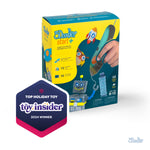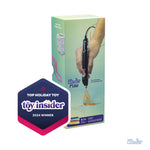3Doodler Reading Pals
In this phonics activity, students will work on decoding strategies in groups of three utilizing the six phonics reading pals, Chunky Monkey, Stretch-it-out-Snake, Skip-it Frog, Eagle Eye, Tryin' Lion, and Fishy Lips, as mnemonics. After reviewing and practicing each reading strategy, students will doodle each reading pal, place it on a binder ring and identify when to use each one in a reading activity.

KnowledgeStudents havepracticed single letter sounds of alphabet letters.
an understanding of how to use each of the 6 phonics reading pals as a reading strategy.
experience reading text using reading pal strategies.
had practice outlining and filling in areas with the 3Doodler.
practiced single letter sounds of alphabet letters.
an understanding of how to use each of the 6 phonics reading pals as a reading strategy.
experience reading text using reading pal strategies.
had practice outlining and filling in areas with the 3Doodler.
ObjectivesStudents willuse tools, i.e., 3Doodler to doodle phonics reading pals.
identify when to use the appropriate phonics reading pal strategy.
apply phonics reading pal strategies effectively during guided reading instruction.
use tools, i.e., 3Doodler to doodle phonics reading pals.
identify when to use the appropriate phonics reading pal strategy.
apply phonics reading pal strategies effectively during guided reading instruction.
MaterialsStudents will need3Doodler (1 per trio)
3Doodler Reading Pals Worksheet (1 per trio)
3-inch binder ring (1 per trio)
3Doodler (1 per trio)
3Doodler Reading Pals Worksheet (1 per trio)
3-inch binder ring (1 per trio)
Lesson PlanInstructions
Step 1Whole group: Project your tablet or computer screen on the board for students to view the 3Doodler Reading Pals Worksheet. Explain that these are all friends we've used to help us decode words. Practice using each one.
a. Chunky Monkey: Use to chunk a longer word into smaller parts. Example: The word "monkey" is chunked as "mon-key."
b. Stretch-it-out-Snake: This pal is especially good for words with consonant blends.
Example: The word "snake" is sounded out as "s-n-ake."
c. Fishy Lips: Before reading a word, look at the first letter and get your lips ready to make that first sound.
d. Tryin' Lion: This pal never gives up. If he can't read a word. He tries again.
e. Eagle Eye: This pal looks at other words in the sentence, using context clues to figure out the difficult word.
f. Skip-it Frog: This pal skips over a difficult word to read the rest of the sentence and then hops back to it to see if he can figure it out.
Step 2Whole group: Model how to use the 3Doodler to outline each reading pal on the 3Doodler Reading Pals Worksheet.
Step 3Circle the room to assist and assess.
Tip: Integrate tactile learning by having students feel the shape of the reading pal as they explain how it is used to help decode words.
Step 4Adding a loop and binder ring. Depending on the ability level of the student, you may or may not need to add the doodled reading pals to each group's ring.
Step 5During guided reading, have students work in small groups to practice using each reading strategy with their 3Doodler Reading Pals. Instruct students to stop each time they use one, hold up the selected reading pal, point to the word and employ the associated strategy.
Whole group: Project your tablet or computer screen on the board for students to view the 3Doodler Reading Pals Worksheet. Explain that these are all friends we've used to help us decode words. Practice using each one.
a. Chunky Monkey: Use to chunk a longer word into smaller parts. Example: The word "monkey" is chunked as "mon-key."
b. Stretch-it-out-Snake: This pal is especially good for words with consonant blends.
Example: The word "snake" is sounded out as "s-n-ake."
c. Fishy Lips: Before reading a word, look at the first letter and get your lips ready to make that first sound.
d. Tryin' Lion: This pal never gives up. If he can't read a word. He tries again.
e. Eagle Eye: This pal looks at other words in the sentence, using context clues to figure out the difficult word.
f. Skip-it Frog: This pal skips over a difficult word to read the rest of the sentence and then hops back to it to see if he can figure it out.
Whole group: Model how to use the 3Doodler to outline each reading pal on the 3Doodler Reading Pals Worksheet.
Circle the room to assist and assess.
Tip: Integrate tactile learning by having students feel the shape of the reading pal as they explain how it is used to help decode words.
Adding a loop and binder ring. Depending on the ability level of the student, you may or may not need to add the doodled reading pals to each group's ring.
During guided reading, have students work in small groups to practice using each reading strategy with their 3Doodler Reading Pals. Instruct students to stop each time they use one, hold up the selected reading pal, point to the word and employ the associated strategy.
Wrap Up
*Note: Students' doodled Reading Pals do not need to be perfect. The more students doodle, the better their doodles will become over time.
Assessment
Possible Extensions
Resources
Vocabulary
alphabet - set of letters or other characters with which one or more languages are written especially if arranged in a customary order.
drawing - the art or technique of representing an object or outlining a figure, plan, or sketch by means of lines.
language arts - the subjects (such as reading, spelling, literature, and composition) that aim at developing the student's comprehension and capacity for use of written and oral language.
literacy - the quality or state of being literate.
phonics - a method of teaching beginners to read and pronounce words by learning the phonetic value of letters, letter groups, and especially syllables.
reading - the form or version of a given passage in a particular text.
sight words - commonly used words that young children are encouraged to memorize as a whole by sight, so that they can automatically recognize these words in print without having to use any strategies to decode.
word family - commonly used words that young children are encouraged to memorize as a whole by sight, so that they can automatically recognize these words in print without having to use any strategies to decode.
Educational Standards
Recognize that spoken words are represented in written language by specific sequences of letters.
Students will recognize written language as spoken words during guided reading practice.
Isolate and pronounce the initial, medial vowel, and final sounds (phonemes) in three-phoneme (consonant-vowel- consonant, or CVC) words.1 (This does not include CVCs ending with /l/, /r/, or /x/.)
Students will sound out words isolating and pronouncing the initial, medial vowel, and final sounds.
Know and apply grade-level phonics and word analysis skills in decoding words.
Students will apply grade-level phonics to decode words during the guided reading practice.
Demonstrate basic knowledge of one-to-one letter-sound correspondences by producing the primary sound or many of the most frequent sounds for each consonant.
Students will demonstrate basic knowledge of one-to-one letter-sound correspondences by producing the primary sound or many of the most frequent sounds for each consonant during the guided reading practice.
Decompose (break down) a larger problem into smaller sub-problems with teacher guidance or independently.
Students will break down the process of decoding words through a procedure of reviewing, doodling and employing reading strategies.
Use technology to seek feedback that informs and improves their practice and to demonstrate their learning in a variety of ways.
Students will use the 3Doodler to create Phonics Reading Pals.
Create original works or responsibly repurpose or remix digital resources into new creations.
Students will use a 3Doodler to doodle Phonics Reading Pals.
Use collaborative technologies to work with others, including peers, experts or community members, to examine issues and problems from multiple viewpoints.
Students will seek feedback from a partner during all stages of the process for this phonics activity.





